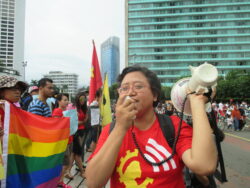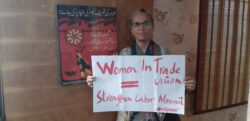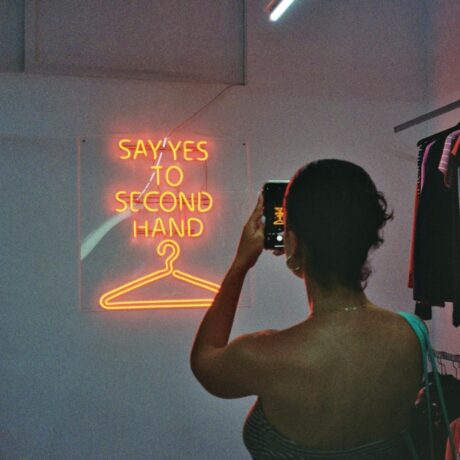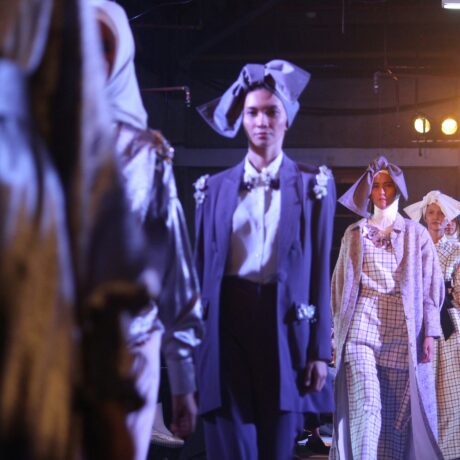Fashion’s gender-based violence crisis: Union leaders share how they’re fighting to end harassment
This is a guest blog by Lizzie Rivera, founder of sustainable lifestyle hub Live Frankly.
For women at the forefront of fighting for garment workers’ rights, the battle is about more than building safety and factory working conditions – it’s about fundamental global women’s rights.
It’s estimated that up to 80% of garment workers are women. Many live in highly patriarchal societies where they face discrimination and oppression for being female – and brands are exploiting this for cheap labour.
Worse still, harassment and violence are being used in factories to prevent women from gaining other fundamental rights, including the right to earn a living wage. So, women union leaders from across Asia are teaming up with one goal in mind – to end gender-based violence in textile factories across the continent.
Resolute in their belief that we are more powerful when we work together, they are combining their decades of experience and expertise to support each other across borders.
This Fashion Revolution Week, five female union leaders from India, Indonesia, Pakistan, Sri Lanka and Cambodia share empowering stories of their struggles and successes – and what inspires them to keep going, against all odds.
Dian Septi Trisnanti, Indonesia
Chairwoman of the Federation of Indonesian United Trade Unions (FSBPI), co-producer of video documentary ‘Angka Jadi Suara’ (Numbers Become Voices)

“Helping other women is healing for me. We are oppressed, yet we stand in solidarity with each other. We face hardship, yet we share our kindness. That’s what inspires me to keep going when I’m being arrested and beaten by police officers for protesting. It empowers me to continue to speak out when the board members or bosses I’m negotiating with speak to me or touch me inappropriately, even though the common response is: ‘Maybe he was just trying to be nice’.
I started out as a journalist and soon realised it doesn’t matter what industry you’re in – wherever we work, women face similar oppression. I find working in the garment industry a lot of pressure and it can be hard to handle. We receive a lot of cases detailing women’s abuse, including sexual harassment and rape. It’s so common we still have to put up signs in factories that say: “This is a sexual harassment free-zone”.
Despite their low wages, female garment workers are often the breadwinners but our culture refuses to recognise that. Women, so used to being reduced, don’t see it in themselves, either. The fact is that brands from the west exploit this gender imbalance.
During the height of the pandemic, a factory operated a shift system, so that only fifty per cent of workers worked at one time. The first shift started at 6am, and the workers would have to wake up in the middle of the night to do all the housework and arrive at 5.30am. Many did not have breakfast. There was added pressure because women had to work weekends to make up the hours or have their wages cut. Can you imagine how exhausting it was for them?
I want women around the world to know the story behind their clothes, the story of exploitation. I want them to know so they stand in solidarity and help the voices of women garment workers to be heard.”
Rukmini Vaderapura Puttaswamy, India
President of Garment Labor Union (GLU) based in Bengaluru, Karnataka state and Co-chair of the Women’s Leadership Committee of Asia Floor Wage Alliance

“I worked as a tailor in garment factories for 23 years. I saw all kinds of sexual harassment, verbal abuse, impossible targets, and a lack of benefits. I became a target when I joined a union and started speaking out for others. The managers tried to publicly humiliate me by criticising my work. They wouldn’t grant my holiday requests. They even followed me to the toilet.
It’s clear brands only respond to crises when they have to – this is why putting global pressure on them to protect workers is so important. Women are more powerful when we work collectively. That’s why we need unions, and for unions to work together.
Many garment workers don’t have much education or any awareness of their rights. They’re women who go from being controlled by men at home to being controlled by men at work. Brands and factories exploit this by paying them very low wages, threatening salary cuts for absence, and refusing to give them long-term contracts so they remain vulnerable.
The best factories are the ones that are willing to address issues when a union confronts them. Without a union, factories can fire workers without notice. When a union is present they are more likely to follow legal procedures and give workers benefits, such as leave.”
Lalitha Dedduwakumar, Sri Lanka
Co-chair of the Women’s Leadership Committee of Asia Floor Wage Alliance and Chief Organizer and founding member of Textile Garment and Clothing Workers Union

“During COVID, apparel sector workers were declared essential workers in Sri Lanka. At the same time, all workers suffered temporary pay cuts of 50 per cent. This meant some people couldn’t afford to get to work. Now, the government is rewarding state sector workers with a 5,000 Rupee (£12) pay rise, which will increase monthly wages by about 10-15%, but garment workers aren’t entitled to this.
There are several reasons for this discrimination. The first is that the vast majority of garment workers are women. There’s a structural violence against women that has become normalised in society and it has become normalised inside the factories as well. It’s not unheard of for women to be nicknamed after the machines they work on – for example “Juki Kalla” (‘Juki’ is the sewing machine brand and ‘Kalla’ is a derogatory way of saying ‘a girl’) or “Juki Baduwa” (‘Baduwa’ implies someone is a prostitute and is also a way of slut-shaming) – rather than by their names.
There’s also racism. There’s been an increase in migrant workers, who don’t necessarily speak Sinhala. They are treated as second-class citizens and denied access to government assistance.
Underpinning all of this is the class issue. Even working in trade unions, as a working-class woman I have experienced discrimination and purposely been kept out of certain policymaking processes. That’s why we founded a trade union led by female ex-apparel sector workers.
It takes a lot of courage for women to join a union and to stand up for themselves and each other. They risk their job, intimidation, and discrimination from employers. It’s especially difficult for women who are used to being controlled to show leadership. What’s incredible is that when a woman becomes used to working in a safe environment and she is treated with dignity and respect, it changes her expectations of how she is treated in her home and community, too.”
Zehra Khan, Pakistan
Founding member and General Secretary, Home Based Women Workers Federation (HBWWF) and member of many tripartite committees in Pakistan, including the Sindh Home Based Workers Governing Body.

“Change is coming. Not just in the workplace, but also in the home. One woman told me her husband no longer hits her because she’s not isolated anymore, she now has 3000 union members standing behind her!
It’s a common story. Domestic abuse declines when men consider their wives to be more equal partners in earning money and running the household. Husbands and fathers realise the benefits of educating women, rather than fear it. Men are now joining our union too, and even those that are not members are coming to us for advice and legal support.
Our union is the first one created for Pakistan’s so-called “invisible workers” – the home-based workers, which we estimate accounts for about 12 million women in Pakistan. Home-based workers typically work 12 – 14 hour days. They use their own electricity and gas. They receive very low wages, sometimes paid in other currencies, and often their daughters assist with the work for no payment at all.
When we founded the Home Based Women Workers Federation in 2009, our initial goal was to create a cooperative where women could support each other and negotiate collectively, to give them more power. Then, we realised they didn’t just need help starting a business. We needed to make home-based workers visible in the eyes of the law so they would be entitled to receive a minimum wage and gain access to health and pension schemes.
Following almost a decade of protesting in the streets and meetings with legislators, the first legislation that recognised the rights of home-based workers was passed in 2018.
In the early days, we had to persuade women of their rights and they were afraid to take part in protests. Now, they ask when the next demonstrations are and they chant slogans in the streets. Members are part of ‘tripartite committees’, for example the Sindh Minimum Wage Board, set up so unions, employers and governments can officially negotiate on important issues. They also use their experience to support other movements, from helping formal workers to unionise to assisting with indigenous people’s land rights issues.”
Heng Chenda, Cambodia
Vice President, Cambodia Labor Confederation (CLC)

“As a garment worker, I witnessed lots of violence and injustice. At the time, I didn’t understand the law, but I knew in my heart to demand for more.
It’s not easy because these problems stem from societal issues, where women aren’t considered equal to men. The laws aren’t in favour of workers. Factory owners bribe police and hire gangsters to intimidate us. But, if we don’t challenge this now, future generations will face the same violations.
Our goal is for all girls and women to understand their rights and be able to stand-up for themselves. We do this by working to increase the amount of female managers in factories and female leaders in unions – and to ensure their leadership is respected. At the same time, we campaign for labour laws that give women maternity rights and criminalise gender-based violence.”








